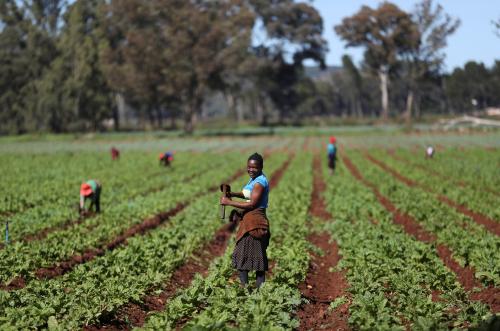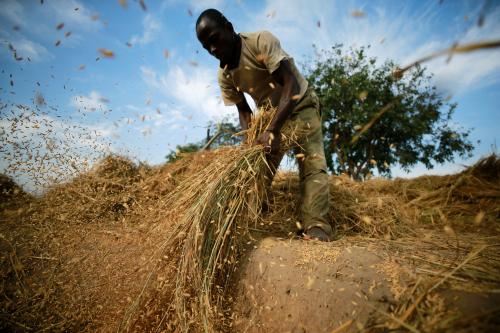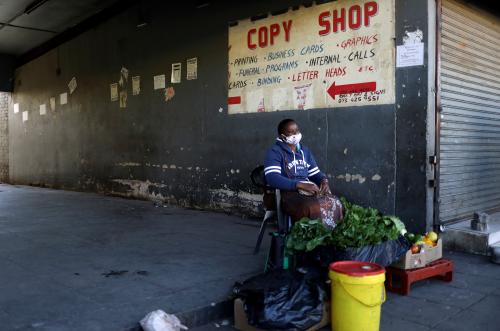While the agriculture sector employs more than 50 percent of sub-Saharan Africa’s workforce, employment in the sector has steeply declined by nearly 18 percent from approximately 61.7 percent in 2000 to 52.3 percent in 2020. However, in spite of this decadeslong trend, a recent report by the World Bank reveals that sub-Saharan African household employment in agriculture has risen since the beginning of the COVID-19 pandemic. The research leverages data from high frequency phone surveys conducted by the National Statistic Offices of five sub-Saharan countries: Burkina Faso, Ethiopia, Malawi, Nigeria, and Uganda.
Figure 1 from the report displays the percentage of households participating in agriculture before and after the outbreak of the pandemic, isolating columns for crop farming, livestock production, and a combined measure of the two (either crop farming or livestock production). In this way, the authors posit that the pandemic may have led participation in crop farming and either crop or livestock to rise in all five countries sampled, though participation in livestock production in Uganda fell.
Figure 1. Household participation in agriculture by country
 Note: Data on livestock production in Ethiopia was excluded from the study due to a lack of information on post-pandemic livestock production in the country at the time of the report.
Note: Data on livestock production in Ethiopia was excluded from the study due to a lack of information on post-pandemic livestock production in the country at the time of the report.
Source: World Bank, Impact of COVID-19 Crisis on Agriculture: Evidence from Five Sub-Saharan African Countries, 2021.
Overall, survey results suggest that workers who were not previously employed in agriculture are now moving into the sector. Figure 2 depicts the movements in and out of agriculture since the outbreak of the pandemic in an effort to delve deeper into the net effects of Figure 1. The report defines “movements into agriculture” as “households who were not involved in agriculture pre pandemic but are doing so since the outbreak,” and “movements out of agriculture” as “households who were involved in agriculture pre pandemic but have not engaged in any agricultural activities since the start of the pandemic.” The net movement of households into crop farming is noticeably larger than the net movement into livestock production. Although there has been more movement associated with livestock production than crop farming, the authors note that seasonal changes in employment may explain this phenomenon. Overall, the combined measure (participation in either crop farming or livestock production) reiterates the trend of increasing household participation in agriculture.
Figure 2. Movements in and out of agriculture by country
 Source: World Bank, Impact of COVID-19 Crisis on Agriculture: Evidence from Five Sub-Saharan African Countries, 2021.
Source: World Bank, Impact of COVID-19 Crisis on Agriculture: Evidence from Five Sub-Saharan African Countries, 2021.
Notably, urban and rural households have behaved differently during the crisis when it comes to household participation in agriculture (Figure 3). Although movement into crop farming has increased across the board, the figure shows this trend has been more prevalent among urban households. The authors speculate that the high rate of urban households participating in agriculture may reflect employment and food security challenges related to the pandemic’s disproportionate negative impacts on urban communities than their rural counterparts.
The authors also highlight another pattern: Rural households’ livestock-production entrance rate is nearly equivalent to its exit rate. In Uganda, however, the number of households exiting livestock production has been greater than those entering. More specifically, the authors posit that movement away from livestock production may be due to the pandemic, which has impacted access to animal health services, feed, and markets in rural communities.
Figure 3. Urban vs. rural household participation in agriculture by country
 Source: World Bank, Impact of COVID-19 Crisis on Agriculture : Evidence from Five Sub-Saharan African Countries, 2021.
Source: World Bank, Impact of COVID-19 Crisis on Agriculture : Evidence from Five Sub-Saharan African Countries, 2021.
For more on the economic impacts of COVID-19 on African agriculture, read “Economic impact of COVID-19: Protecting Africa’s food systems from farm to fork.” For more on Africa and food security during the pandemic, read “Protecting food security in Africa during COVID-19” and “Figures of the week: The effect of COVID-19 on food and income security in Africa” For more on COVID-19 and employment in Africa, read “COVID-19 and the future of work in Africa: How to shore up incomes for informal sector workers.”








Commentary
Figures of the week: Household participation in agriculture on the rise since the outbreak of COVID-19
February 3, 2021